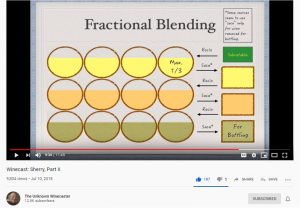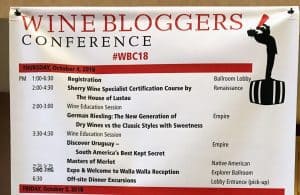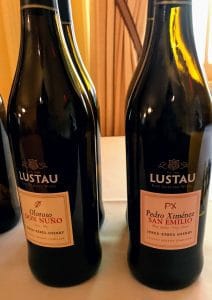Want more Sherry geeking? Check out my post on the 8 Myths about the Sherry Solera System that even Wine Geeks Believe.
When it comes to studying wine, I’m a fan of taking a multi-prong approach to learning. Reading wine books and crafting flashcards are great, but your goal should be more than just rote memorization.

To have the info really stick with you, you need to make it meaningful. That involves connecting the concepts to something else that you’ve already learned or experience. For me, that “experience” part is vital. Of course, the very best way to learn about a wine region is to actually visit the place and talk to the people who make it.
But that’s not always possible to do. So I find the next best thing is to seek connections between the material I’m learning to other audio and visual experiences. I’ve talked before about how useful I find wine podcasts to be in supplementing book learning. Often these podcasts feature interviews with people intimately connected to the wine I’m studying. I find that hearing, in their own voice, key insights will solidify these details more in my mind.
That takes care of the audio component, but what about the visual? What’s a good way to get a feel for a wine region and the culture that shapes its wines? This is where the oodles of free content on YouTube steps in.
Now not everything on YouTube is great.
While I’ve found tons of useful stuff, a lot of it is just “meh.” It takes a bit of effort to find the videos (especially in English) that have truly educational content. One of the things that you’re going to have to wade through is promotional material done by wineries, retailers & distributors. These aren’t necessarily bad (though I’ve found plenty of errors in many retailer & distributor videos). But you have to remember that the goal of these vids is more about selling wine than teaching.

I also recommend having some chamomile tea while studying Manzanilla. Not only is it a trademark tasting note but also the word “Manzanilla” is the Spanish name of chamomile.
There is also a lot of wine video content that focuses on wine reviews (a la Gary Vaynerchuck’s old WLTV format). Again, these aren’t bad but, from a wine student’s POV, there’s minimal value in the tasting notes of other people. You can read reviews if you want. Watching someone sniff, sip and spit on camera to tell you the same thing isn’t going to help you understand the influence of biological aging under flor any better.
But having a glass of Manzanilla yourself, though, can make a world of difference. Especially if you’re pairing that glass with watching aerial drone shots of just how close Sanlúcar de Barrameda is to the Atlantic’s influences while listening to a winemaker describe the conditions they need to maintain flor.
That will go much further in hammering home those fundamental concepts than any wine review ever will.
My criteria:
In compiling this list below, I focused on the videos that I think put a “face” on the Sherry wine region beyond pictures & descriptions in wine books. Not all of these videos will have stellar production value. But I do believe that everything here delivers enough meaningful content to warrant the time to watch them.
Of course, this list won’t be exhaustive. So if you know of another great Sherry wine video, please post them in the comments!
GuildSomm’s The Wines of Sherry (11:01)
By far, GuildSomm produces some of the best content that any wine student can find. Well worth subscribing to their channel!
At the (5:40) mark, there is an excellent demonstration of how the fractional blending of the solera system takes place. However, the narration and explanation of the tools used for this process is better in Jamie Goode’s short (2:39) video.
The Gastro Traveler’s All About Sherry! || The secrets behind Spain’s misunderstood wine! (10:09)
A great video to help you get a “feel” of the Jerez region with several worthwhile interviews. I also enjoyed paying attention to the writings and markings on the barrels during the bodega visits–spotting even a rare vintage Añada barrel at Tio Pepe at the (4:09) mark.
The Culinary Institute of America’s Sherry Wine of Andalucía (9:49)
It’s no surprise that a video from the CIA would focus a lot on the food pairing qualities of Sherry. But I found this immensely useful in developing blind tasting strategies for the various styles of Sherry by connecting them to food pairing concepts. Now when tasting a Sherry blind, I’ll let my mind wander towards what kind of food I want to pair it with–matching intensity & weight, bridge ingredients, etc. It’s been helping.
Paul Gormley & Antonio Souto’s Discovering Jerez/Sherry (25:28)
The Gormley video is not on the same scale when it comes to production quality as the previous three videos. It looks like a travel video from the early 1990s. But there is still some good content here with interviews and visuals of the region and winemaking.
In particular, I like where César Saldaña, the director of the Consejo Regulador, goes into more details about Sherry food pairings than he did in the CIA video above. For instance, I sometimes have difficulties distinguishing Amontillados from Olorosos. But at (5:23), Saldaña talks about pairing Amontillado with strong tuna and poultry while Oloroso is more for robust red meats. With Amontillados having more salinity and aldehydes from its partial time under flor, I can see those flavors going towards seared tuna much better than they would for a sirloin.
Vinos de Jerez TV’s Sherry Wines (6:58)
The dramatic music and narration of this video is hilariously hokey. However, even if you mute the audio, there are still a lot of great visuals of the vineyards and winemaking of Sherry. Starting at the 2:09 mark to 3:09, there is some cool “History Channel” type footage of Sherry’s history that I’ve not seen from other sources. It’s pretty much that one single minute of content as to why this video made the list.
But I will say, after a couple glasses of Sherry (and not spitting), the groan-worthiness of the over-the-top narration becomes immensely amusing.
BONUS: The Unknown Winecaster
This falls outside of my criteria of highlighting YouTube videos that give a “feel” for a wine region. But the Unknown Winecaster is a channel that every wine student should subscribe to. He did a four-part series on Sherry that is broken down into very manageable bites.

Screenshot from Part 2 of the Unknown Winecaster’s series on Sherry (July 20th, 2018)
Part 1 (12:18) – An Intro, the grapes & region
Part 2 (11:45) – The production process
Part 3 (12:47) – The different styles
Part IV (8:32) – Special age designations and food pairings
Essentially these are free wine classes with high-level content delivered on Powerpoint that the Winecaster narrates. If you’ve ever taken an online university course, these winecasts will give you déjà vu. But I mean that as a compliment and testament to the academic quality of the material.
A Tip:
In my opinion, the best way to use these winecasts is as a review after you’ve done the bulk of your studying and just before you take your exam. If you start with these in the beginning, you’re going to get bogged down in taking notes instead of really listening or absorbing the content.
By using these winecasts as a review tool, you can sit back and focus only on the material that jumps out to you as unfamiliar. And, believe me, no matter how much you’ve studied or think that you have a region down pat, I guarantee you that the Unknown Winecaster will drop a little nugget of knowledge that you haven’t stumbled upon yet.
For me, it was being introduced to the albedo effect
This triggered a light bulb moment in how the reflectiveness of the white Albariza soils helps with water retention.

It’s particularly crucial for wine students pursuing WSET certifications to be able to move beyond listing facts towards connecting those concepts to how it impacts the vine & wine.
Every wine student will memorize the advantages of Albariza.
It’s not very fertile.
It retains water.
The clay and silica mixed with the limestone form a crust to reduce evaporation.
It’s very crumbly and allows roots to penetrate deep.
It stays cool but reflects heat on the canopy to aid ripening.
That last part on reflectiveness is almost always connected in rote memorization to the impact on the grapes (staying cool to maintain what little acidity Palomino has as well as allowing leafier canopies for shading without jeopardizing ripeness). Yet, that albedo effect cooling also plays a key role in limiting the evaporation of the water in the soils. It makes perfect sense when you stop and think about it so I feel silly that it hadn’t clicked earlier. But it’s one of those connections that you often overlook when you’re memorizing flashcards.
This is the value in taking a multi-prong approach to your wine studies. You never know what’s going to flip that light switch.



